The flame angelfish (Centropyge loricula) is one of the most popular of the dwarf angelfish species. Spot one in a tank, and you’ll realize why they’re so popular. The fish get their name from the fiery red bodies, set off with an orange center – almost as if they possessed a fiery core. They also have black bars on the sides and deep blue ends to their fins. Put it together, and you have a striking fish that’s perfect for any reef tank.
Table of Contents: Flame Angelfish
Compared to some of the larger members of the group, flame angelfish are much more manageable. You don’t need as much space (that “dwarf” part of the dwarf angelfish group), and they’re not as prone to misbehavior as some of their cousins. Of course, you still have a few quirks you’ll need to watch for. That’s where the following top ten frequently asked questions will help you decide whether the species works for you. Feel free to jump to the section that interests you most. Or you can scan the entire article and earn the most interesting facts about keeping these brilliant saltwater aquarium fish.
- Flame Angelfish Natural Habitat
- Are Flame Angels Considered Hardy?
- How Long Do Flame Angelfish Live?
- How Large Do Flame Angelfish Get?
- What is the Minimum Tank Size to Keep Flame Angels?
- Are Flame Angelfish Reef-Safe?
- What Do Flame Angelfish Eat?
- Are Flame Angelfish Aggressive?
- What are the Flame Angelfish’s Compatibility, Behavior, and Suitable Tank Mates?
- What are the Common Diseases and Parasites of Flame Angels?
- Flame Angelfish Breeding
- How Much Do Flame Angelfish Cost?
- My Personal Experience with Flame Angelfish
- Pros and Cons
- For More Information
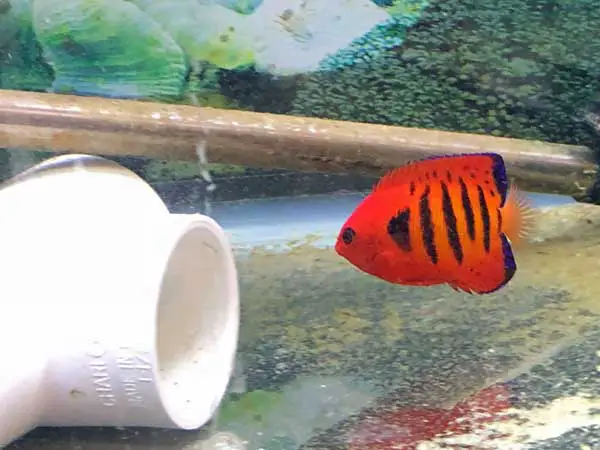
Flame Angelfish Natural Habitat
One of the best features of flame angelfish is its vibrant colors. You can’t miss them, even in a stunning reef tank display. But did you know the region the fish inhabit determines their appearance? True story! The species ranges throughout the tropical Indo-Pacific, but you’ll find minor variations depending on exactly where you look.
In the central Pacific, you find two possibilities, depending on which of the island reefs you visit. Around Marshall Island, the angels take on a vibrant red, with almost no orange showing on the scales. They also have much thicker black bars down the sides. In contrast, the fish have the traditional red-orange combination and thin black stripes around the Christmas Islands. Same region, but two possibilities for appearance.
As you head toward Hawaii, you’ll see the solid red color emerge again, with less of the orange tint showing through. You also get the fluorescent blue edges on the fins. They’re the most popular version of the flame angelfish.
Then there are the flame angels around Cebu and Tahiti. These fish don’t usually make it into the fish stores that often. They’re a dark red (think the color of blood) with blurry black bars down the sides. You can also see a touch of yellow between the stripes (still flame-like). If you spot one, know it’s a rare find (and likely to cost you more).
Flame angelfish – regardless of what part of the Pacific they’re hanging out in – stick around stony coral reefs. They prefer clearer waters, and they stay on the outer fringes. You don’t find them very deep, either – no more than 16-82 feet (4-25m). The colorful fish form small schools of between 3-7 fish. They’re ALWAYS moving, picking around the rocks and corals for their next meals.
You may also see flame angelfish in fish stores as dwarf flame angel, flaming angel, or Japanese pygmy angelfish.
Are Flame Angels Considered Hardy?
Flame angelfish work well for hobbyists of any experience level. And one of the reasons why is their hardiness. Despite their collection from the wild, they adapt into home aquariums without too much trouble. You still need to perform a two-week quarantine, of course, but you shouldn’t struggle with acclimation. They also don’t require a specialized diet (which will get to in a moment). The one exception to the “hardy” definition is their susceptibility to marine ich, but we’ll go into that in more depth in a few minutes.
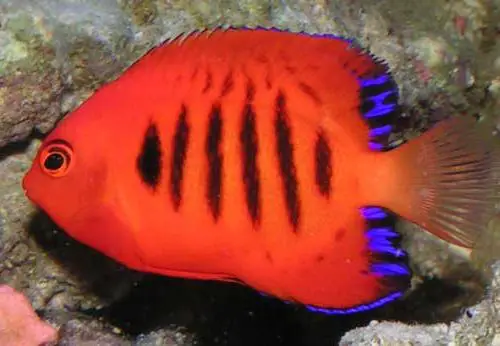
How Long Do Flame Angelfish Live?
On average, they’ll survive between 5-7 years in a reef tank.
That’s with optimal care, though. And, unfortunately, while they’re considered a hardy species, they don’t do as well with the collection and shipping processes. The initial stress leaves them vulnerable to the marine parasites they bring with them. And if you’re not careful with that quarantine period, you may not see your flame angelfish survive for very long.
It’s critical that you ask your local fish store to hold your flame angel for a couple of weeks before you bring it home. That way, you’ll ensure the fish is healthy enough for the trip to your aquarium. You don’t want to risk bringing an ill or weak fish into your display. Not when you’re spending that kind of money. (Don’t worry, we’ll cover that topic, too)
How Large Do Flame Angelfish Get?
Compared to your average angelfish, flame angels ARE miniature. They only reach an adult size of around 6 inches (15.2cm). Males usually stretch further than the females, too. Not the smallest fish in an average saltwater aquarium, but “dwarf” compared to the more oceanic angelfish species out there.
Of course, in captivity, you may only see your flame angelfish reach 4 inches (10.2cm) in length. Still not a bad size for a centerpiece fish. And plenty large enough to cause problems for the smaller species in the tank if you’re not careful.
What is the Minimum Tank Size to Keep Flame Angels?
When it comes to setting up a tank for flame angelfish, the consensus online is – that there isn’t a consensus. You’ll find sites that recommend as little as 45 gallons (170L) and others that go up to 70 gallons (265L). People add notes whether you’re keeping a single angel or anticipating a pair (or even a school). And trying to boil down ONE standard’s nearly impossible. So let me share my perspective on the matter.
Flame angelfish swim around the tank A LOT. The little fish never seem to stop swimming – even when you think they should pause to sleep. Everyday routines include swimming and nibbling algae on rocks and the aquarium glass. But the fish is also on the small side. Now, I’ve successfully raised flame angels in a 70-gallon (265L) tank without any issues. So my recommendation is somewhere in between: A 55-gallon (208L) tank feels appropriate. And if you can offer 48 inches (121.9cm) of length, you’ll give this fish an excellent territory to zip around in.
However, if you’re planning to keep a pair or school of flame angelfish, consider doubling your tank size. You want to ensure you’ve got room for swimming space and live rock. The bigger your tank, the less crowded you’ll make things. Besides, “bigger is better” is always a good mantra to follow in this hobby.
Are Flame Angelfish Reef-Safe?
The flame angelfish is reef safe, with some cause for caution. You can expect to safely keep them with other reef fish, corals, & invertebrates in an aquarium. Caution is advised due to the observation that certain individual fish may nip at corals in some situations.
Generally speaking, they’re not a problem for corals. After all, their natural environment is on the reef fringe throughout the Pacific. They even enjoy plucking algae from rock structures, removing the pest before it can compete with your frags. But that’s where the problem starts. Flame angels aren’t above nibbling on fleshy polyps. And it’s down to the individual fish whether they’ll decide to chew on your corals.
Now, they won’t pose a problem to your shrimp, crabs, or other mobile invertebrates. Clam mantles may pose the same temptation as the polyps, though, so keep an eye on things. Many reef tank owners are willing to roll the dice to keep these gorgeous fish in their aquariums. And there’s always the chance your flame angel won’t show any interest in your corals. But you should have a backup plan – just in case. You don’t want to risk your beautiful display tank.
In my experience with flame angelfish over the years, they were reef-safe. (I lucked out)
What Do Flame Angelfish Eat?
Flame Angelfish are omnivores. They scavenge the reef for algae and microorganisms between the nooks and crannies of rocks and coral in the wild.
You should expect them to continue to do the same in your aquarium. And the more varied a diet you provide, the better those red and orange colors will pop under your lights. (Yes, that means a diet that includes both meaty and vegetative foods)
Some of the best options to consider for flame angels includes:
- Angelfish commercial foods
- Brine shrimp
- Mysis shrimp
- Spirulina
- Marine algae
- Marine flakes or pellets
- Shaved shrimp
- Sheets of nori
You read that correctly; nori works as an ideal source of vegetation if your tank doesn’t have algae for your flame angelfish to graze on. This YouTube video shows a fish chowing down on the seaweed:
You can also set up a refugium to grow macroalgae and help supplement the protein offerings for your colorful fish. (Remember, you want variety and high-quality dietary options)
Are Flame Angelfish Aggressive?
Flame Angelfish are generally considered to be semi-aggressive, which means that most of the time, they will get along with most of the other community reef fish. Occasionally they will have territorial disputes with more peaceful fish species and they are generally intolerant of other angelfish.
If you’ve encountered the larger angelfish species out there, you know they can turn into bullies in the home aquarium. And it’s only natural to wonder if the dwarf cousins possess the same mean streak. As it turns out, it’s possible. Flame angelfish are considered semi-aggressive. They have a habit of turning on other angelfish and displaying territoriality towards fish added to an aquarium after they’ve established their territory. This translates to thinking ahead when you decide you want to include flame angels in your display tank.
You CAN manage the aggression levels with some planning. The more space you provide, the less likely you are to see problems. And if you add your flame angelfish LAST, it won’t have a chance to set up a territory in the tank. This calms down that mean streak (actually, it prevents it from forming). Then you’ll have more harmony within your aquarium. You can also limit in-fighting (if you’re considering a school) by keeping just ONE flame angel. Males fight with each other. If you really want more than one, consider a mated pair.
What are the Flame Angelfish’s Compatibility, Behavior, and Tank Mates?
Despite their “semi-rough” reputation, flame angelfish usually display sky behaviors when they first enter a new environment. They may hide out among the rockwork in your tank until they acclimate. You’ll want to ensure they have caves and crevices to retreat into. Once they feel at home, expect to see them venturing out into the open swimming space. And that’s when you’ll notice their usual bold behavior (to match that striking color palette).
When kept together, flame angelfish usually do well together – for the most part. You CAN see fighting between males, though. And those squabbles can lead to the death of one of the fish. This is why you’re better off sticking to a bonded pair or ONE fish. Even with plenty of space in the aquarium, flame angels will seek each other out to move in a school. And that can lead to fighting issues among the individuals – particularly during the spawning season.
As for setting up a community tank, you want to look for other semi-aggressive species. That way, your flame angelfish won’t get tempted to bully anyone. Of course, you’ll need the proper tank space to ensure everyone gets room to swim and explore. But you can safely incorporate flame angels with any of these groups:
- Anthias
- Clownfish
- Tangs
- Wrasses
If you’re feeling brave, you can also add aggressive fish to the mix. You just want to choose species that come out SMALLER than your flame angel. That way, THEY don’t end up picked on and harassed. You don’t want any stress or strife in the tank. You can always consult compatibility charts if you want to remain on the safe side.
What are the Common Diseases and Parasites of Flame Angels?
While hardy, flame angelfish tend to bring skin parasites like saltwater ich with them when they’re collected. This is why it’s crucial to quarantine and monitor your new purchases for any signs of white spots. The stress of transportation leaves the fish vulnerable for the parasite to invade, leaving them infested. And that’s the LAST thing you want for your display tank. Besides ich, flame angels often bring marine velvet with them.
If you happen to notice either parasite during the quarantine phase, you can quickly treat them. Both respond to increasing your water temperature or using over-the-counter medications. Ideally, you want to catch the problem BEFORE the fish enter the display tanks. You can’t use most drugs around invertebrates. So don’t skip that quarantine.
Flame angelfish may also contract Vibrio bacterial infections. It’s not common, but you’ll want to keep a close eye on any new purchases (especially if you ordered your fish online). Watch for popeye, dropsy, or bleeding on the skin. Vibrio kills fish FAST, so you want to catch the signs as quickly as possible. You can treat the bacterial infection with a freshwater dip.
Flame Angelfish Breeding
When it comes to breeding flame angelfish, you’re welcome to give it a try, but you need to set reasonable expectations for yourself. Plenty of hobbyists have tried, but the success rate is low. And among those who managed, they admitted that raising the fry proved tricky.
To start with, telling males and females apart takes work. Other than a size difference, the two look similar. You may notice slightly brighter colors on males, but that’s the only clue you get. And, of course, maintaining more than a pair requires a large tank with plenty of room to prevent aggression.
Then you encounter the natural biology of the flame angelfish. The species are sequential hermaphrodites. All are born female. As the fish grow and mature, the most dominant in the schools then switch to males. If that fish happens to pass away, then the next most dominant fish will become male to replace the balance in the group. So, if you have a pair, you’re guaranteed to end up with a male and female. (That’s the easy part) It takes around two months for the conversion to complete.
Flame angelfish are broadcast spawners. They rise into the water column in the evening hours and release the gametes into the plankton. There’s no parental care, and most of the eggs don’t survive to hatch 24 hours later. It’s a similar pattern in the home aquarium, where plenty of the flame angels’ tank maters are happy to snack on the eggs.
Now, if you’d like to attempt to breed your flame angelfish, you’ll want as deep of an aquarium as possible. That way, your fish can duplicate that swim to the surface. You can also encourage the spawning behavior by scheduling your lights to imitate the day-night pattern for several weeks. (Turn half off for two hours to simulate dusk) Once the flame angels spawn, you’ll need to collect the eggs and transfer them to a separate nursery tank to protect them.
You can feed the fry on green water algae. Once they’re large enough, they can transfer to brine shrimp nauplii, rotifers, and copepods.
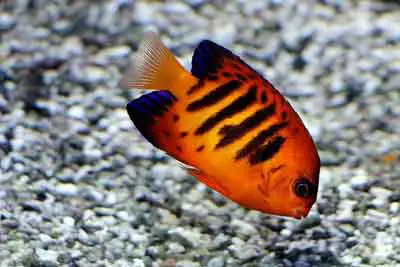
How Much Do Flame Angelfish Cost?
Due to the difficulty with captive breeding, most flame angelfish come from wild collection. That means you’re going to end up paying for transportation costs (even if you hit up your local fish store). There’s always variation in price based on where you purchase, where the fish was initially imported from, and the size of the fish you’re interested in. But, generally, you’ll find flame angels in the range of $70-$150.
They ARE on the expensive side of things. And the larger (and more mature) you choose to go, the more you’re going to spend. If you happen across one of the rare varieties, you should also expect to shell out more from your bank account.
My Personal Experience With Flame Angelfish
I’ve been fortunate enough to care for flame angels on three occasions. And while I provided the disclaimer that they might develop a taste for soft coral polyps, I never noticed any issues with mine. (Just goes to show the variation in individual fish personalities and preferences)
At least one of the fish I kept seemed extremely susceptible to marine ich and died due to complications from an infestation. That was totally my fault, though, not his/hers.
Otherwise, my flame angelfish were a delight to keep. Their extremely bright, bold colorations and active swimming made them a tank favorite for anyone who saw them.
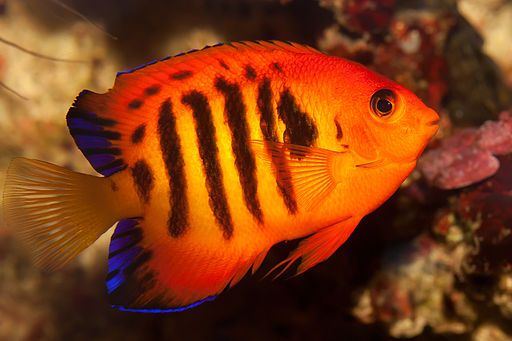
Pros and Cons
Your reef tank WILL gain color with flame angelfish. But let’s keep some essentials in mind before rushing to the fish store (or clicking that “Buy Now” button online):
Pros
- Flame angelfish are generally considered reef-safe, although some individuals may turn out to be polyp nippers.
- Flame angels are generally peaceful towards other non-angelfish.
- Flame angelfish are easy to feed, hardy, and moderately easy to keep.
Cons
- Flame angelfish need a lot of swimming space and prefer to live in groups; they are NOT a nano tank species.
- Due to needing to collect them from the wild, flame angels are expensive.
- Because they’re not easy to breed in captivity, flame angelfish are only available as wild-caught specimens taken directly from the reef.
For More Information
Flame angelfish catch the eye. And with reasonable management anyone can handle, they’ve earned that spot in the popularity charts. If you’re looking for even MORE information on these striking fish, take a look below.
If you’re interested in learning more about the flame angelfish, check out this YouTube video:
Want to learn about another great angelfish species?
Or maybe you’re interested in other fish species that would look stunning with your flame angelfish:
- Most popular saltwater fish
- 7 Coolest Saltwater Fish for Beginners
- Functional Saltwater Fish
- Starter fish (Here, you’ll find the coral beauty angelfish, an alternative to the flame angel – NOT a compatible tank mate)
Conclusion
Take one look at the flame angelfish, and it will become apparent why they’re such a popular (and expensive) saltwater fish species. As you start to learn more and more about them, you’ll wonder how you ever did with out in your tank. Sure, you need to take care with quarantine. And maybe you’ll never start a successful breeding operation. But isn’t it worth it to have a gorgeous red and orange beauty swimming through your reef tank? (Assuming your fish doesn’t care for coral polyps, of course) You know it is!
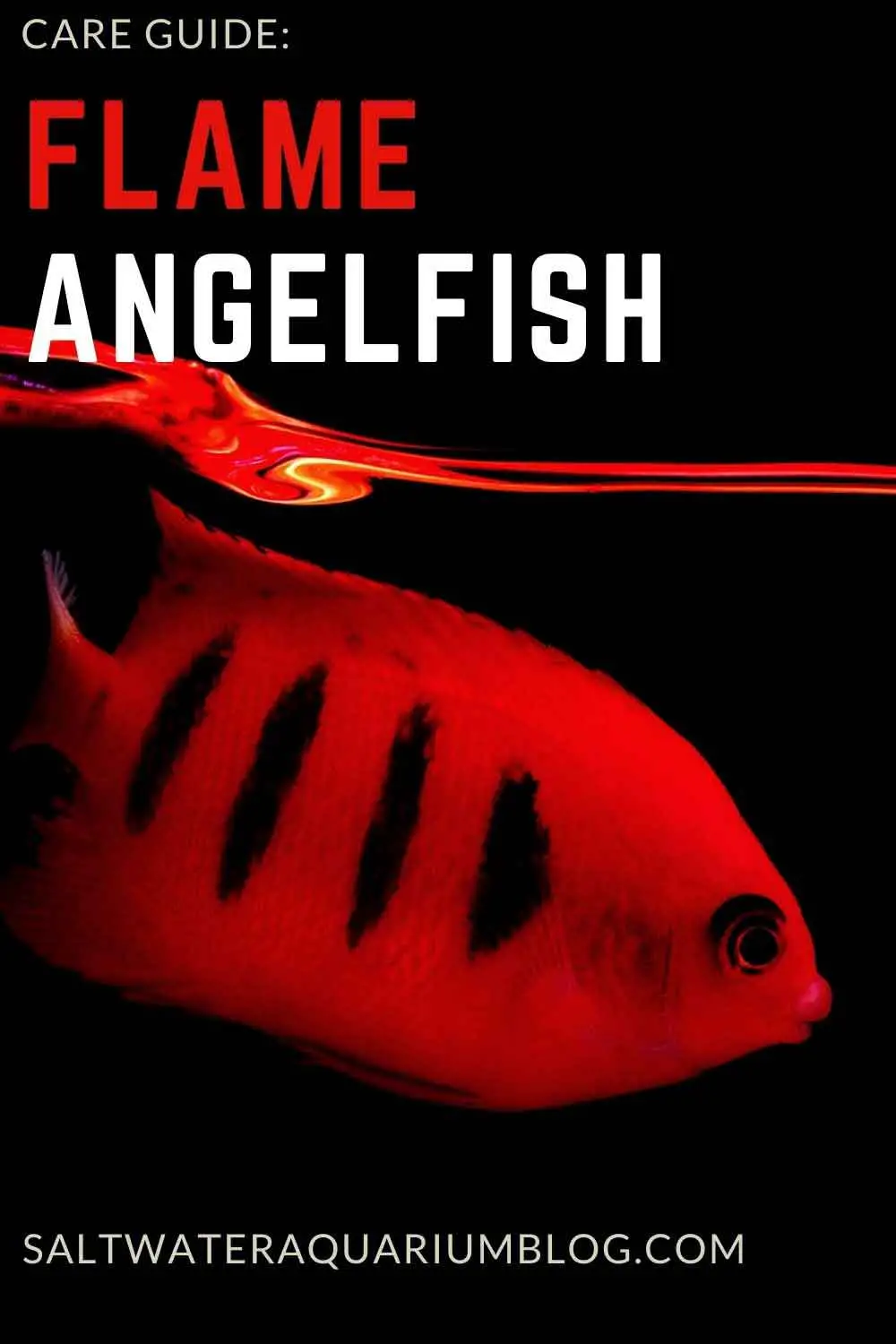
What’s your experience been with the flame angelfish? Let me know in the comments!


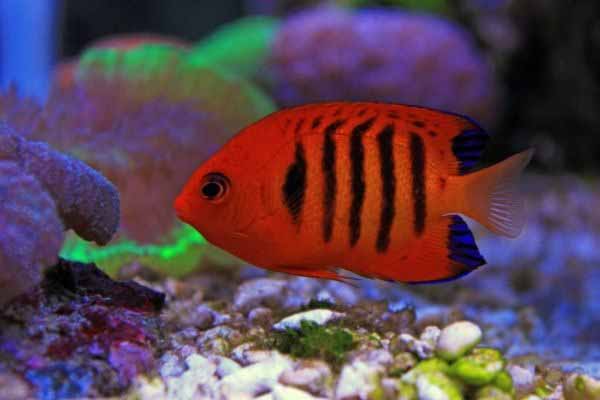
Leave a Reply